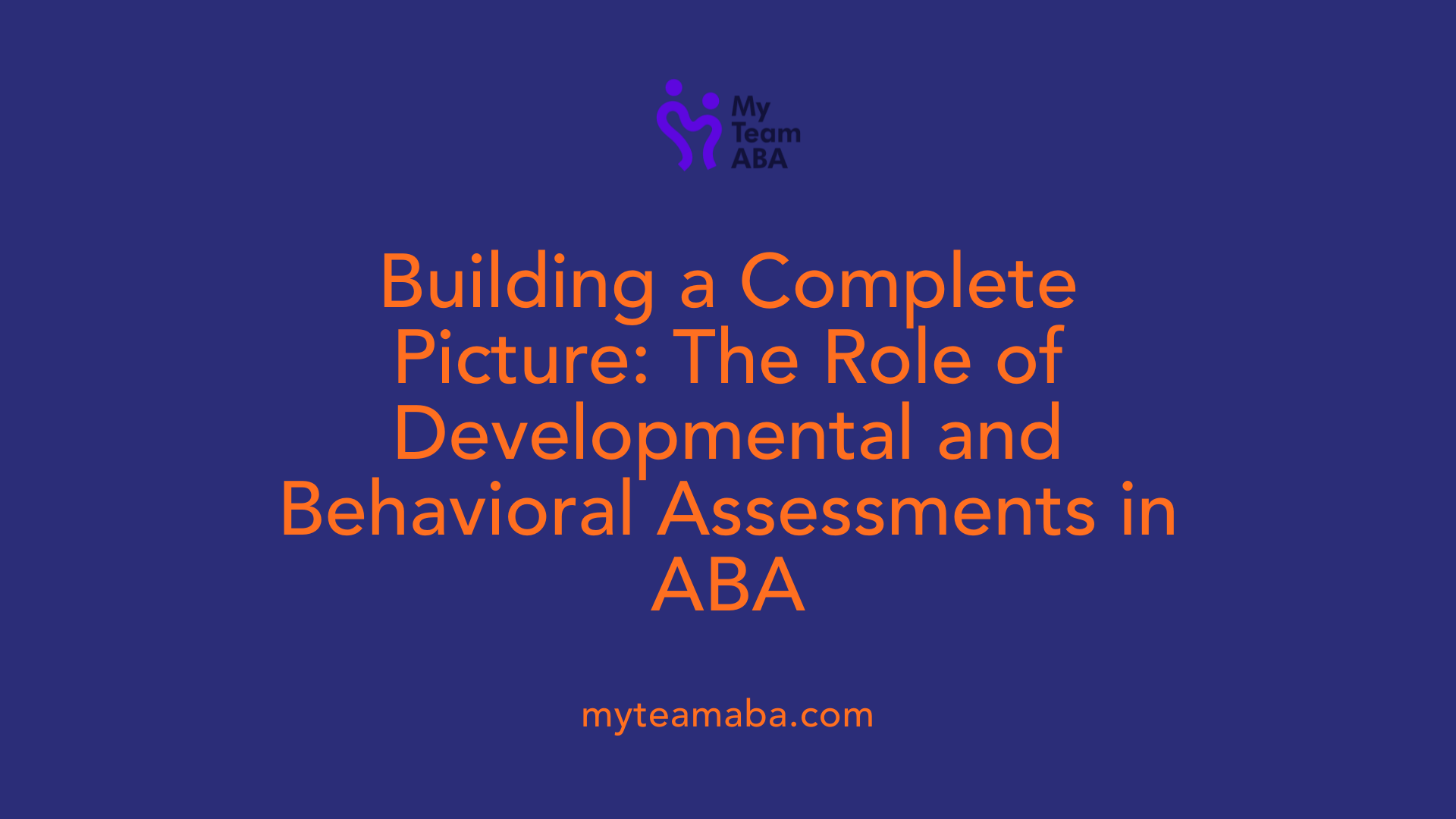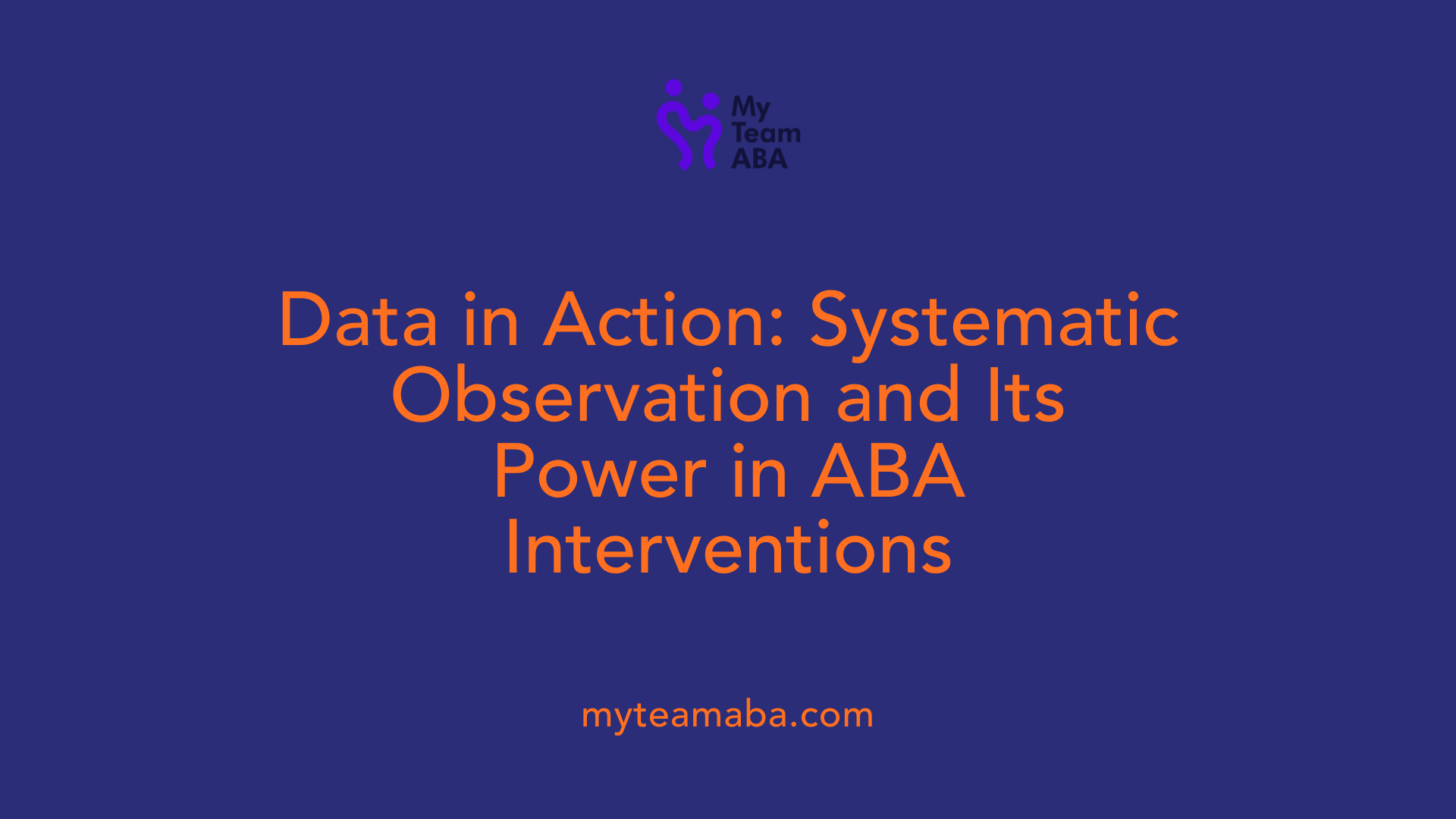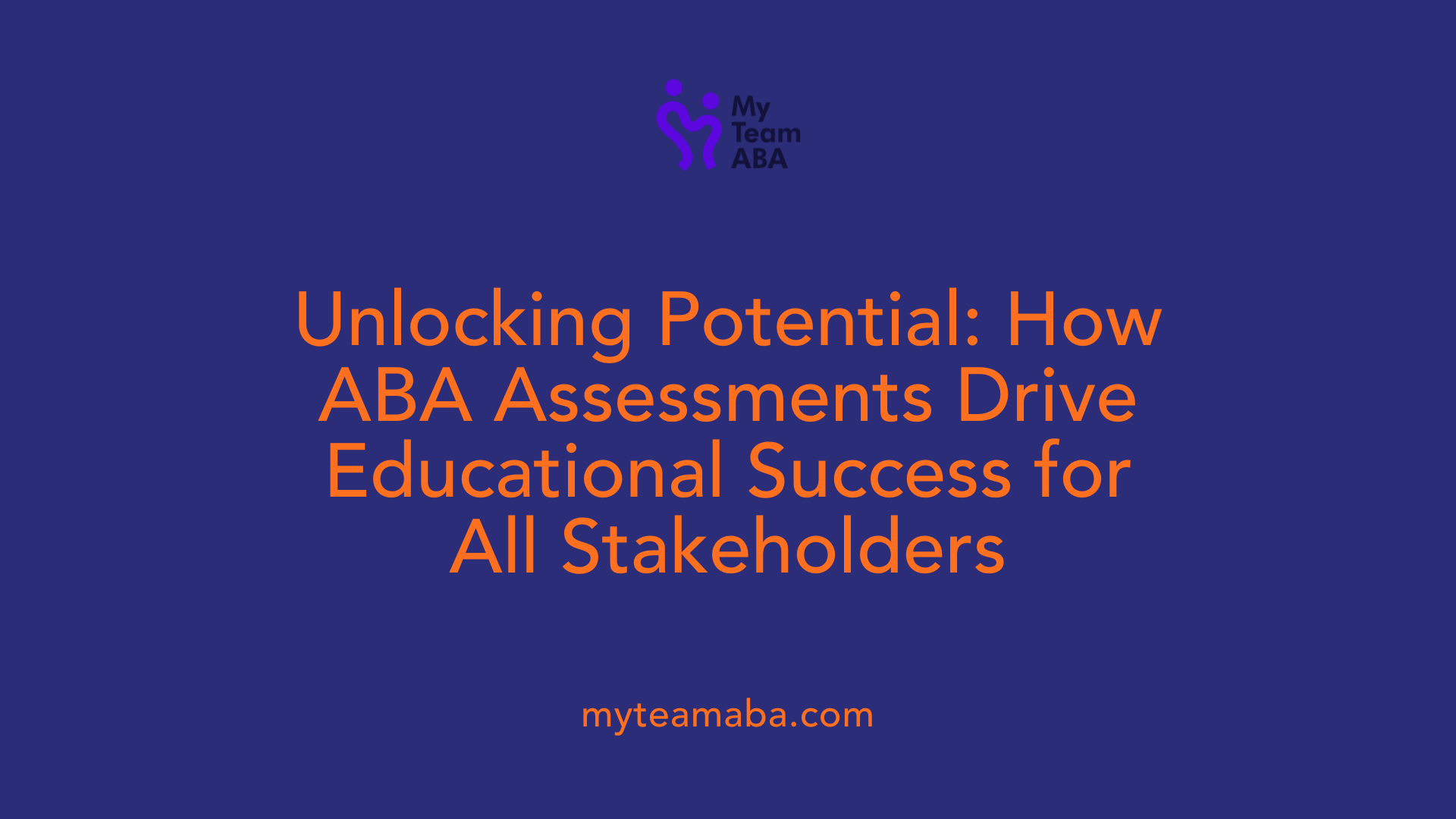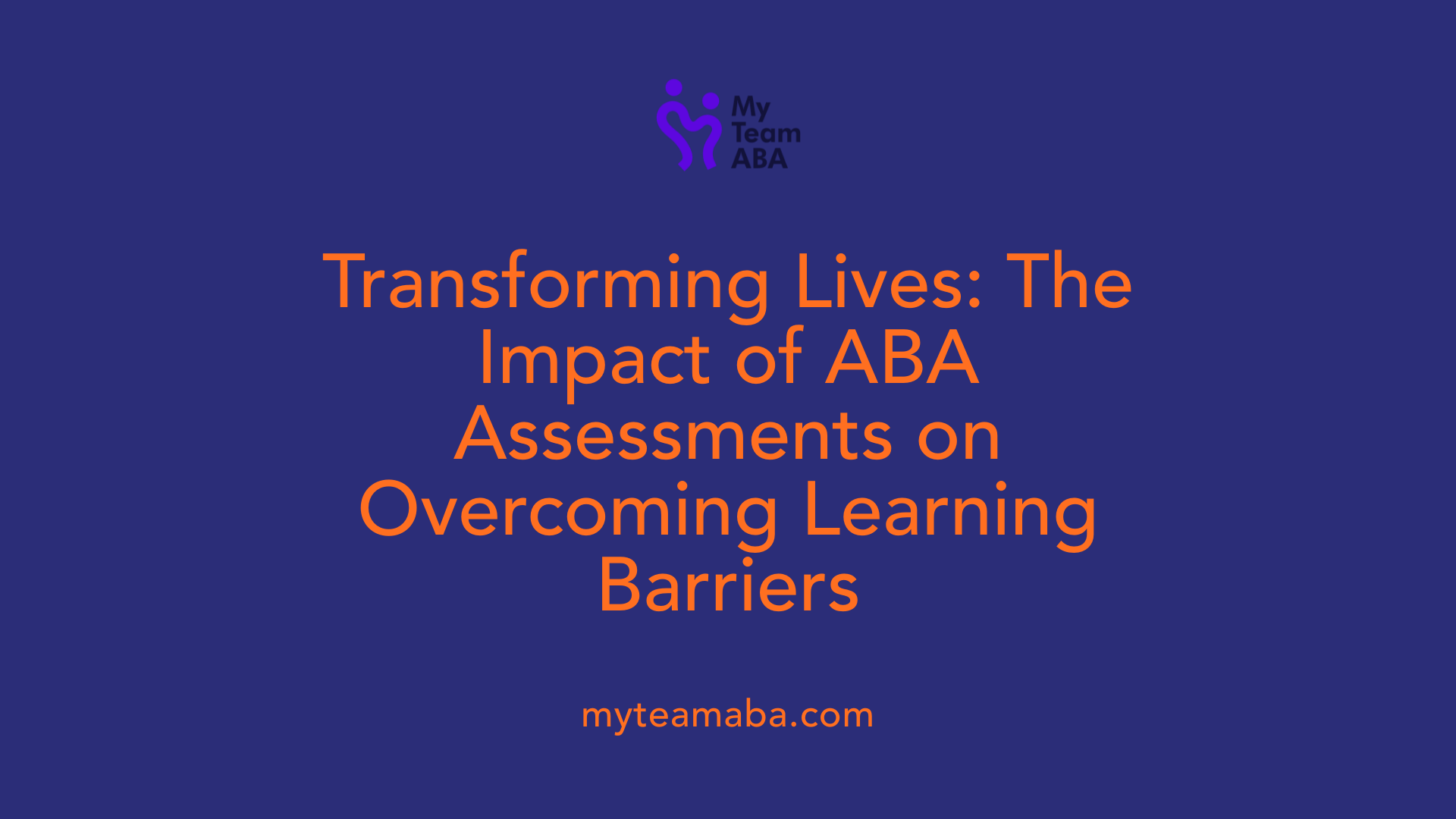How ABA Assessments Help Identify Barriers to Learning
July 24, 2025
Unlocking Learning Potential: The Power of ABA Assessments in Identifying Barriers

Understanding Barriers to Learning Through ABA
Applied Behavior Analysis (ABA) assessments serve as a fundamental step in recognizing the various obstacles that hinder effective learning, especially in children with developmental disabilities. These assessments provide detailed insights into an individual's current skills, behavior patterns, and environmental factors, enabling tailored intervention strategies that promote growth and independence. This article explores how ABA assessments function, the tools used, and their critical role in identifying and overcoming learning barriers.
The Significance of ABA Assessments in Educational Development
Why are assessments important in ABA therapy?
Assessments serve as the foundation of effective ABA therapy by offering a detailed snapshot of an individual's skills and behaviors. Tools like the ABLLS-R, AFLS-R, and VB-MAPP evaluate different domains, including language, social skills, daily living skills, and behavior patterns. This comprehensive understanding helps practitioners determine strengths and pinpoint areas needing support.
Using this information, therapists can design tailored interventions that address each person's unique needs. For example, if assessments reveal difficulty with communication, language-focused strategies can be prioritized. These evaluations also track progress over time, enabling adjustments to be made to ensure ongoing development.
Moreover, assessments help identify barriers such as prompt dependence or behavioral triggers that hinder learning, allowing for targeted management. This continuous monitoring enhances treatment efficacy and promotes meaningful growth. Ultimately, thorough assessments maximize positive outcomes by guiding personalized and adaptive ABA interventions.
Core Assessment Tools in ABA and Their Functions
Overview of VB-MAPP, ABLLS-R, and AFLS-R assessments
The VB-MAPP, ABLLS-R, and AFLS-R are widely used tools in behavioral analysis to assess different skill domains in individuals with developmental disabilities, particularly autism spectrum disorder.
The VB-MAPP (Verbal Behavior Milestones Assessment and Placement Program) concentrates on language development and social skills using principles from B.F. Skinner’s analysis of verbal behavior. It evaluates milestones such as requesting, labeling, and responding to questions, helping to identify language barriers.
The ABLLS-R (Assessment of Basic Language and Learning Skills - Revised) measures 25 skill areas, including communication, social interaction, self-help, academic, motor, and play skills. It offers a developmental framework that compares a child's skills with same-age peers and tracks ongoing progress.
The AFLS-R (Assessment of Functional Living Skills - Revised) focuses on practical life skills essential for independence. It covers personal care, home management, community participation, social skills, and vocational abilities, emphasizing real-world applicability.
Measures of language, social, self-help, and life skills
All three tools evaluate critical functional skills. For example:
- VB-MAPP assesses language acquisition and social interactions.
- ABLLS-R evaluates a broad array of skills, including social and academic capabilities.
- AFLS-R assesses daily living skills like dressing, toileting, and community engagement.
These assessments provide valuable insights into a child's current abilities across multiple domains, highlighting areas needing targeted intervention.
Use of checklists and inventories to identify developmental gaps
Each assessment employs structured checklists and skill inventories to gather comprehensive data. Checklists enable precise identification of skill deficits or barriers to learning, such as difficulty with communication or self-help tasks.
For instance, the VB-MAPP checklist can pinpoint delays in requesting or labeling, which might hinder social participation or academic success. Similarly, the ABLLS-R's detailed skill areas help identify specific strengths and weaknesses, guiding tailored interventions.
By systematically comparing an individual’s responses across different tasks and contexts, these assessment tools reveal developmental gaps that may contribute to learning challenges. Recognizing these gaps allows clinicians and therapists to design personalized strategies focused on overcoming specific barriers.
Which ABA assessment tools measure barriers to learning?
Several ABA assessment tools are designed to identify barriers to learning, with the VBMAPP being a primary example. The VBMAPP evaluates verbal behavior milestones and developmental areas, helping to pinpoint skill deficits that may serve as barriers. These assessments often include checklists and skill inventories that identify areas where a child may struggle, such as communication, social skills, or self-help abilities. By understanding these barriers, clinicians can develop targeted intervention strategies that address specific developmental gaps. Overall, assessment tools like the VBMAPP play a crucial role in identifying barriers to learning and guiding effective ABA interventions.
Understanding Developmental and Behavioral Assessments

Why are assessments important in ABA therapy?
Assessments are fundamental in ABA therapy because they offer a detailed picture of an individual's current skills and behaviors. They help professionals pinpoint strengths and pinpoint areas needing support, guiding the development of targeted interventions. Regular progress tracking through assessments allows practitioners to see what strategies are working and make timely adjustments. They also reveal barriers such as prompt dependence or challenging behaviors that can impede learning.
By gathering comprehensive data, assessments facilitate personalized and effective treatment plans, ensuring therapy is both efficient and aligned with individual needs. This systematic approach ultimately enhances the potential for meaningful progress and positive outcomes in behavior and skill development.
Differentiating developmental assessments from functional behavior assessments (FBA)
Developmental assessments, such as ABLLS-R and VB-MAPP, focus on evaluating broad skill areas, including communication, social skills, academic performance, and motor abilities. They compare an individual’s skills to those of same-age peers and help identify developmental strengths and weaknesses.
In contrast, Functional Behavior Assessments (FBA) concentrate specifically on understanding the causes and functions of challenging behaviors. FBA involves observing behavior patterns, identifying triggers, and understanding why behaviors occur, such as seeking attention or avoiding tasks. This targeted approach helps develop effective behavior management strategies.
While developmental assessments provide a general overview of skills, FBAs are more focused on behavior functions. Both are essential in creating holistic intervention plans.
Purpose and scope of social and emotional assessments
Social and emotional assessments delve into how individuals interact with others and manage feelings. They help identify difficulties in social skills, emotional regulation, and peer relationships, which are common in developmental disabilities.
These assessments provide insights into areas such as expressiveness, social reciprocity, and emotional responses. Understanding these domains supports the development of interventions that enhance social integration, emotional well-being, and adaptive functioning.
How these assessments contribute to a holistic understanding
Combining developmental, behavioral, social, and emotional assessments creates a comprehensive view of an individual's abilities and challenges. This approach ensures that treatment plans address not only skill acquisition but also emotional regulation, social skills, and behavior management.
The data from these evaluations guide personalized interventions, fostering improvements across multiple domains. They also support ongoing progress monitoring, helping practitioners adapt strategies to meet evolving needs. Ultimately, a holistic assessment approach promotes better overall functioning and quality of life for individuals with ASD or developmental disabilities.
Role of Systematic Observation and Data Collection

How can skill assessments help ABA therapy?
Skill assessments serve as a foundation for effective ABA therapy by providing a comprehensive picture of an individual's current skills and challenges. These assessments evaluate crucial areas such as social interactions, communication, motor abilities, and academic skills. They help clinicians develop targeted, personalized intervention plans that align with the child's unique needs.
The process involves various methods, including direct observation, interviews, and standardized assessments like ABLLS-R, VB-MAPP, and AFLS-R. Through direct observation, practitioners watch behaviors in natural settings or structured tasks, systematically recording responses and interactions. Interviews with caregivers and educators offer contextual insights about the child's daily life and functional skills.
Systematic collection of behavioral data allows clinicians to identify patterns, triggers for challenging behaviors, and progress milestones. This data-driven approach ensures interventions are based on measurable information rather than assumptions. It also facilitates ongoing monitoring, making it possible to adjust strategies as the child's skills evolve.
By analyzing collected data, therapists can determine which techniques are most effective, making instruction more efficient. For example, if a child responds well to visual cues, visual supports can be incorporated into their program. Conversely, if progress stalls, interventions can be recalibrated or intensified.
In summary, skill assessments and systematic data collection uplift ABA therapy by providing clarity, guiding personalized interventions, and allowing continuous refinement. This method ensures that each step taken is purposeful and geared towards fostering real, meaningful growth in the child.
Methods like direct observation, interviews, standardized assessments
Effective data collection in ABA utilizes multiple approaches:
- Direct Observation: Watching behaviors as they naturally occur or during structured tasks to record frequency, duration, and intensity.
- Interviews: Gathering detailed information from parents, teachers, or caregivers about the child's behaviors, skills, and daily routines.
- Standardized Assessments: Utilizing validated tools like the ABLLS-R, VB-MAPP, or AFLS-R to measure skill levels systematically and compare them against developmental benchmarks.
These methods create a rich, multi-dimensional understanding of the child's abilities and areas needing support.
Collecting behavioral data systematically
Systematic data collection involves structured techniques to ensure consistency and accuracy. This includes defining clear operational definitions for behaviors, selecting appropriate data recording methods (e.g., frequency count, interval recording, or duration), and scheduling regular assessments. Consistency allows practitioners to track progress reliably over time.
Data collection also typically involves baseline measurements before intervention, followed by continuous monitoring throughout treatment. This ongoing process helps detect subtle changes, assess the effectiveness of strategies, and decide on necessary modifications.
Using data to inform intervention planning
The ultimate goal of data collection is to inform and refine intervention plans. Data analysis reveals which strategies promote learning and which may need adjustment. For example, a pattern of prompt dependence might be identified, leading to the implementation of fading techniques.
Behavior analysts analyze this data to set realistic goals, select appropriate teaching methods, and tailor reinforcement schedules. They also use it to determine if a child is ready for less restrictive environments or if additional supports are necessary.
Through this disciplined approach, ABA therapy becomes flexible and responsive, ensuring that interventions are both effective and aligned with the child's developmental trajectory.
Developing Personalized Treatment Plans Based on Assessment Results
Why are assessments important in ABA therapy?
Assessments play a vital role in ABA therapy because they provide a detailed picture of an individual's strengths, challenges, and the current level of functioning. These evaluations help identify specific skills to target and inform the development of tailored interventions that meet the person's unique needs.
By systematically observing and analyzing behavior patterns through tools like the ABLLS-R, VB-MAPP, and AFLS-R, therapists can pinpoint areas requiring support. This detailed information guides the creation of effective behavior support plans (BSPs), which serve as roadmaps for intervention.
Ongoing assessment is essential for tracking progress and making necessary adjustments. As individuals learn new skills or encounter challenges, continuous monitoring ensures that strategies remain aligned with their evolving needs. Additionally, assessments uncover barriers to learning, such as prompt dependence or sensory sensitivities, enabling targeted approaches to overcome them.
Overall, assessments in ABA therapy are foundational because they ensure that interventions are personalized, data-driven, and adaptable, all of which contribute to more successful outcomes.
Assessment-Based Instruction and Intervention Strategies
How can skill assessments help ABA therapy?
Skill assessments are fundamental in ABA (Applied Behavior Analysis) therapy. They provide a detailed picture of an individual's current abilities across various areas like communication, social skills, self-help, and academics. These assessments help pinpoint strengths and challenges, forming the basis for designing personalized intervention plans.
Various tools such as the ABLLS-R, VB-MAPP, and AFLS are commonly used to evaluate vital skills. For instance, the ABLLS-R assesses over 500 skills across 25 domains, aiding clinicians in identifying specific areas for targeted intervention. The VB-MAPP focuses on language acquisition and social interactions, offering insights into verbal behavior milestones and potential barriers.
By comparing responses and data gathered through these assessments, therapists can determine which strategies are likely to be most effective for individual learners. The assessments serve as a roadmap, guiding the selection of teaching methods, prompts, reinforcement strategies, and instructional formats.
Using data to guide intervention choices
Data from assessments enable precise decision-making in therapy. For example, systematic observation and standardized tests reveal patterns in behavior, such as triggers for challenging behaviors or areas where a child responds well to visual cues. This information helps in choosing specific intervention techniques like visual schedules, sensory-based activities, or social skills training.
Regular progress tracking through ongoing assessments allows therapists to evaluate the effectiveness of implemented strategies. For example, if a child's language skills improve with certain prompts, adjustments can be made to reinforce or expand these techniques. Conversely, if progress stalls, strategies can be reevaluated and modified efficiently.
Comparison of strategies through learner responses
Assessment data also facilitate the comparison of different teaching approaches. Behavior analysts can implement multiple strategies, such as error correction versus reinforcement or varied stimulus arrangements, and measure responses systematically.
This comparison helps identify which approach yields the best learning outcomes, ensuring resource-efficient and effective instruction. For example, a learner might show better verbal request initiation when using a picture exchange system compared to verbal prompts alone.
Adjusting interventions based on ongoing assessment
Continuous assessment throughout therapy allows for dynamic intervention adjustments. As a child develops new skills or encounters emerging challenges, the treatment plan can be tailored accordingly.
For instance, if ongoing data shows that a child is successfully acquiring self-care skills, targets can shift towards more complex tasks or social skills. Conversely, if a child exhibits increased disruptive behaviors, assessment can help determine environmental triggers or skill deficits contributing to these behaviors, leading to targeted interventions.
Moreover, tools like the PEAK Relational Training System or the EFL curriculum assist in fostering relational understanding and independence, adaptable according to assessment outcomes.
By integrating assessment data into daily practice, practitioners optimize learning opportunities, promote positive behaviors, and support meaningful progress.
Identifying and Addressing Barriers to Learning
Which ABA assessment tools measure barriers to learning?
Several assessment tools used in ABA therapy are designed to identify obstacles that hinder learning. One prominent example is the Verbal Behavior Milestones Assessment and Placement Program (VB-MAPP). This tool evaluates language and social skills by assessing milestones such as requesting, labeling, and social interactions, which are often foundational for further learning.
The VB-MAPP includes checklists and skill inventories that help pinpoint where a child might be encountering difficulties, whether in communication, social engagement, or self-help skills. These insights are crucial because they reveal specific areas where a learner may struggle, creating barriers to progress.
Other assessments like the ABLLS-R (Functional Analytic Language System - Revised) and AFLS-R (Assessment of Functional Living Skills - Revised) also contribute to identifying challenges. ABLLS-R examines over 500 skills across domains such as language, play, and academic skills, highlighting deficits that could restrict learning. AFLS-R evaluates everyday living skills critical for independence, such as personal care and community participation, and can pinpoint skills that need reinforcement.
By systematically analyzing a child's performance through these tools, clinicians can identify key barriers to learning. This understanding forms the basis for creating targeted strategies to overcome these obstacles.
Developing effective interventions involves tailoring approaches to the individual’s needs, such as employing visual cues for children who respond well to visual supports or incorporating sensory activities for those with sensory sensitivities. The assessment findings help set realistic, achievable goals for skill development and behavior change.
In summary, tools like VB-MAPP, ABLLS-R, and AFLS-R are instrumental in revealing barriers to learning. They enable practitioners to design precise and effective intervention plans that promote meaningful progress and foster independence.
The Role of Parent and Caregiver Assessments
Why are assessments important in ABA therapy?
Assessments are vital in ABA therapy because they serve as the foundation for understanding an individual's unique needs, strengths, and challenges. They provide a detailed picture of current skills across various domains, including communication, social interaction, self-help, and behavior patterns. This comprehensive understanding enables professionals to develop targeted, individualized intervention plans that are more likely to succeed.
Parent and caregiver assessments play a significant role in this process. They help gather valuable information about the child's developmental history, daily behaviors, and family dynamics. Through methods such as questionnaires, structured interviews, and review of records, caregivers share insights that might not be visible in clinical settings alone.
These assessments also reveal environmental factors influencing the child's behavior and learning. Understanding family routines, routines, and priorities allows therapists to tailor strategies that seamlessly integrate into daily life, increasing the likelihood of success.
Involving parents and caregivers in intervention planning fosters collaboration and ensures that strategies are consistent across settings. Their insights help in setting realistic goals, choosing appropriate teaching methods (like visual supports for visual learners), and establishing a partnership grounded in shared understanding.
Assessments thus empower families to actively participate in the therapeutic process, enhancing the child's progress and overall outcomes. When caregivers are engaged and informed, therapy becomes more effective and sustainable over time.
ABA Assessments and Support for Learning in Children with Developmental Disabilities
How can skill assessments help ABA therapy?
Skill assessments serve as a foundational tool in ABA therapy, providing a comprehensive picture of a child's current abilities and areas needing development. Tools like the ABLLS-R evaluate over 500 skills across domains such as language, social interaction, self-help, academic skills, and motor abilities. These assessments reveal strengths that can be reinforced and weaknesses that require targeted intervention.
By systematically observing and measuring a child's responses, clinicians can identify specific skills to focus on and set realistic, personalized goals. For instance, if a child demonstrates delays in requesting or labeling, therapists can tailor programs to address these language barriers. The information gained from assessments guides the selection of specific teaching strategies, such as prompting techniques or reinforcement schedules.
Furthermore, assessments are crucial for tracking progress over time. Regular re-evaluation allows clinicians to monitor growth, identify emerging challenges, and adjust interventions accordingly. This ongoing process ensures therapies are responsive and effective, fostering better learning outcomes.
How are assessments useful in evaluating progress in children with ASD and disabilities?
Assessments like the VB-MAPP and AFLS provide structured measures of a child's language, social, and daily living skills. The VB-MAPP, based on verbal behavior principles, evaluates language milestones such as requesting, responding, and social interactions, identifying both barriers and progress points.
The AFLS assesses functional living skills essential for independence, such as self-care, home management, and community participation. These tools help determine how well a child applies learned skills in real-world situations.
By comparing results over multiple assessment points, professionals can clearly see improvements or plateaus. This data supports decision-making regarding the continuation, modification, or intensification of intervention strategies.
Progress evaluations also boost motivation for families and caregivers by visibly demonstrating the child's advancements and areas needing ongoing support. Ongoing assessment helps maintain a clear focus on achievable, meaningful progress.
How do assessments support individualized goals and learning environments?
Customized education and therapy plans stem from detailed assessment data. Tools like the ABLLS-R and PEAK Relational Training System help identify a child's specific learning style, interests, and responsiveness to various teaching methods.
For example, if assessments reveal strong visual preferences, therapists may incorporate visual schedules or cues to enhance learning. Conversely, sensory-based or errorless learning strategies might be preferred if sensory sensitivities are identified.
Assessments also help set realistic, measurable goals aligned with the child's current skills and future potential. This person-centered planning ensures that interventions are practical and focused on enhancing independence.
Moreover, understanding a child's strengths and challenges enables caregivers and educators to create supportive environments that facilitate positive experiences and skill acquisition. Regular assessment updates ensure that learning environments evolve alongside the child's development, promoting continual growth.
| Assessment Tool | Focus Area | Main Use | Example Skills Assessed |
|---|---|---|---|
| ABLLS-R | Language, social, academic, motor | Identify strengths and needs for tailored interventions | Requesting, social interaction, academic skills, self-help skills |
| VB-MAPP | Language acquisition, social skills | Measure verbal behavior milestones and barriers | Labeling, requests, response to questions |
| AFLS | Life skills, independence | Evaluate daily living and community skills | Dressing, toileting, community participation |
| Vineland Scales | Adaptive behaviors | Gather caregiver input on daily adaptive skills | Communication, daily living skills, socialization |
Assessment in ABA is a comprehensive process that informs personalized treatment, supports progress tracking, and ensures learning environments are tailored to fit each child's unique profile. Utilizing these tools leads to more effective and meaningful developmental outcomes.
Educational Significance of ABA Assessments for Stakeholders

Why are assessments important in ABA therapy?
Assessments serve as a foundation for effective ABA therapy by providing a thorough picture of a child's current skills, behaviors, and developmental levels. They help identify strengths and weaknesses across various domains such as communication, social skills, daily living, and motor abilities.
For parents, practitioners, and therapists, these evaluations clarify what a child needs to progress and what strategies might be most effective. For example, tools like the ABLLS-R evaluate over 500 skills in 25 domains, guiding interventions tailored to the child's unique profile.
Ongoing assessment allows for continuous progress tracking, making it possible to see if specific interventions work or if adjustments are necessary. This dynamic process ensures that outcomes are optimized, and barriers to learning, including disruptive behaviors, are addressed promptly.
Moreover, assessments like the VB-MAPP and AFLS-R help identify skill milestones and potential obstacles in language, social, and functional living skills. They also pinpoint behaviors needing modification, such as problematic triggers or prompt dependence.
How do assessments benefit different stakeholders?
Parents gain insights into their child's development and can actively participate in therapy planning. This understanding fosters a collaborative relationship with the therapist, promoting consistent support at home.
Practitioners and therapists benefit from structured data collection, which guides the selection of interventions and goals. It enhances therapy precision and helps measure the efficacy of specific strategies.
Collaborative planning improves when all parties understand the child's progress and needs through clear, data-backed reports. This teamwork ensures that therapy goals align with the child's abilities and family priorities, resulting in more meaningful and sustainable improvements.
Improving learning support and communication
Assessment results inform the customization of teaching methods. For instance, visual schedules for children responding well to visual cues or sensory-based activities for those with sensory sensitivities.
They also facilitate clear communication among all team members, ensuring everyone understands the child's current level and expected outcomes.
In conclusion, ABA assessments play a vital role in delivering personalized, effective intervention, fostering better developmental outcomes, and strengthening the partnership among families, practitioners, and educators.
The Role of ABA Assessments in Intervention Planning and Skill Development
How can skill assessments help ABA therapy?
Skill assessments in ABA therapy are fundamental in guiding effective intervention strategies. They provide a comprehensive picture of a child's current abilities across various domains such as language, social skills, self-help, and motor skills. For example, tools like the ABLLS-R evaluate over 500 skills in 25 areas, helping therapists identify strengths and weaknesses.
These assessments enable clinicians to set personalized, realistic goals tailored to the child's needs. By systematically observing and measuring behaviors, they identify not only what the child can do but also areas requiring support. This detailed data allows for designing targeted interventions that promote learning and skill acquisition.
Furthermore, ongoing assessments track progress over time, informing whether strategies are effective or need adjustment. For instance, if a child is not making expected gains in communication, therapists can modify approaches, such as integrating visual cues or play-based methods. This dynamic process ensures therapy remains responsive and efficient.
Assessment results also aid in identifying triggers of challenging behaviors, helping to develop supportive behavior management plans. Tools like the Functional Behavior Assessment (FBA) analyze behavioral patterns, offering insights into causes and guiding intervention.
Overall, skill assessments serve as a roadmap for individualized therapy, optimize learning outcomes, and support the child's journey toward greater independence and functional skills.
Facilitating tailored interventions and skill acquisition
Assessment findings inform the selection and sequencing of instructional strategies. For example, the VB-MAPP evaluates language milestones and social skills, pinpointing specific barriers to communication. With this information, therapists can introduce appropriate language curricula such as the PEAK Relational Training System to build conceptual understanding.
Moreover, assessments like the AFLS-R focus on practical living skills, ensuring that interventions target real-world tasks like dressing, grooming, and community participation. These assessments help set clear, attainable benchmarks, setting the stage for incremental learning.
Evaluation of intervention effectiveness
Ongoing assessments allow practitioners to monitor progress and evaluate the impact of interventions. Data collected through direct observation, standardized tests, and caregiver input are compared against baseline measures. If progress stalls or regressions occur, therapists can analyze the data to determine the cause and adjust strategies accordingly.
This continuous feedback loop ensures that interventions remain effective and aligned with the child's evolving needs. For example, if a child's social responding improves, but language skills lag, therapists may intensify targeted language activities.
Supporting lifelong learning and independence
Assessment tools such as the EFL and Vineland Adaptive Behavior Scales emphasize skills necessary for independence, including daily living, social interactions, and vocational skills. These evaluations help set lifelong goals, guiding the development of support plans that foster autonomy.
By systematically measuring and tracking these skills, therapy can evolve from early intervention to ongoing skill reinforcement, supporting lifelong learning. This approach encourages gradual independence, enabling individuals to participate actively in their communities and achieve personal goals.
| Tool/Assessment | Focus Area | Application | Additional Insights |
|---|---|---|---|
| ABLLS-R | Language, social, academic | Establishing personalized intervention goals | Assesses more than 500 skills |
| AFLS-R | Daily living, community skills | Teaching real-world functional skills | Focus on independence and self-help |
| VB-MAPP | Verbal and social skills | Language development milestones and barriers | Based on verbal behavior theory |
| EFL | Life skills and independence | Curriculum for lifelong skills | Emphasizes person-centered planning |
| Vineland | Adaptive behavior | Parent/caregiver input for daily life skills | Wide range of adaptive behaviors |
Assessments like these form the backbone of effective ABA therapy by ensuring interventions are personalized, measurable, and adaptable, ultimately fostering meaningful and sustainable skill development.
Conclusion: The Transformative Impact of ABA Assessments on Learning Barriers

Why are assessments important in ABA therapy?
Assessments form the foundation of effective ABA therapy. They provide a detailed picture of an individual's strengths, weaknesses, and areas needing support. With tools like the ABLLS-R, AFLS-R, and VB-MAPP, professionals can evaluate critical skills in communication, social skills, daily living, and language development.
These assessments help identify the specific barriers an individual faces, such as challenges in verbal communication or difficulties in social engagement. By understanding these factors, therapists can design targeted interventions that address the root causes of problematic behaviors or learning difficulties.
Ongoing assessments are equally vital as they allow for continuous progress tracking. This means therapy plans can be regularly adjusted to maximize effectiveness, ensuring that interventions evolve with the individual's development.
In addition, assessments facilitate early diagnosis and intervention. Recognizing developmental delays or behavioral issues early can significantly improve long-term outcomes, especially in children with autism spectrum disorder (ASD).
Improving early diagnosis and tailored interventions
Early assessment enables more precise and personalized treatment strategies. For example, the VB-MAPP helps determine language milestones and barriers, guiding language-focused interventions. Likewise, the AFLS-R emphasizes real-world skills that foster independence in daily living and community participation.
Personalized treatment plans based on thorough assessments promote quicker skill acquisition and reduce frustration for both the individual and caregivers. They support setting realistic goals aligned with the child’s current capabilities and growth potential.
Moreover, assessment data allows therapists to compare progress against developmental benchmarks and peers, ensuring interventions remain relevant and effective.
Enhancing learning and independence
By identifying specific skill gaps, assessments directly contribute to enhancing learning outcomes. They help develop customized educational and behavior support plans that target individual needs.
For example, in teaching self-help skills like dressing or toileting, assessments highlight which behaviors have been mastered and which require focus. This targeted approach boosts confidence and promotes independence.
Additionally, assessments like the PEAK Relational Training System foster cognitive flexibility and reasoning, vital for adapting to new situations and solving problems.
Ultimately, the goal of ABA assessments is to support young learners and individuals with developmental disabilities in gaining essential skills—leading to improved quality of life, greater independence, and full community participation.
| Assessment Tool | Focus Area | Benefits | Typical Users |
|---|---|---|---|
| ABLLS-R | Language, Social, Academic | Insights for tailored interventions | Clinicians, Educators |
| AFLS-R | Daily Living & Community Skills | Promotes independence | Therapists, Caregivers |
| VB-MAPP | Verbal & Social Skills | Language milestones & barriers | Speech Therapists, Behavior Analysts |
| Vineland | Adaptive Behavior | General adaptive functioning | Pediatricians, Psychologists |
| PEAK | Language, Reasoning | Cognitive flexibility & reasoning | Behavior Analysts, Educators |
This comprehensive approach, grounded in systematic assessments, transforms how learning barriers are understood and addressed. It ensures interventions are precisely targeted, leading to meaningful progress and enhanced independence for individuals with ASD and developmental disabilities.
Advancing Learning Outcomes Through Assessment-Driven Strategies
In conclusion, ABA assessments are invaluable tools that illuminate the barriers to learning faced by individuals, enabling tailored interventions that foster skill development and independence. By systematically evaluating skills and behaviors, these assessments guide effective planning, monitor progress, and facilitate early diagnosis of developmental challenges. Their application ensures that therapy is personalized, responsive, and aligned with each individual's unique needs, ultimately transforming learning experiences and enhancing quality of life.
References
- Understanding Key ABA Assessments: ABLLS-R, AFLS-R, and VB ...
- ABA Assessment: What is It? | Circle ABA - The Autism Impact Circle
- A Tutorial for the Design and Use of Assessment-Based Instruction ...
- ABLLS-R Assessment: What Parents Need to Know - Blue ABA
- The Crucial Role of Parent Assessments in ABA Therapy
- Common Assessments in ABA Therapy - GentleCare Therapy
- SKILL ASSESSMENTS - ABA Autism Therapy and Treatment
- Autism Treatment Resources - ABA Therapy
